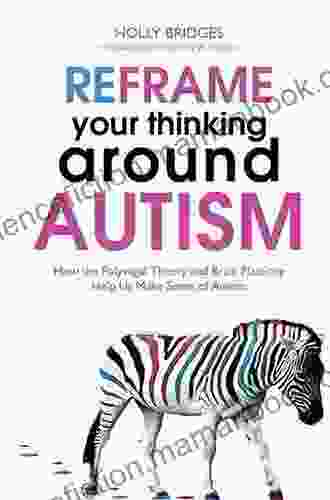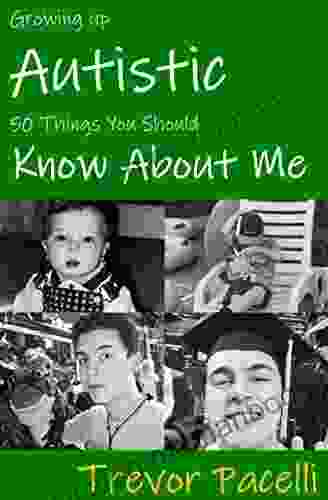How the Polyvagal Theory and Brain Plasticity Help Us Make Sense of Autism

Autism Spectrum Disorder (ASD) is a neurodevelopmental condition characterized by social challenges, communication difficulties, and repetitive behaviors. While the exact causes of autism remain elusive, research suggests that it involves complex interactions between genetic and environmental factors.
4.3 out of 5
| Language | : | English |
| File size | : | 1541 KB |
| Text-to-Speech | : | Enabled |
| Enhanced typesetting | : | Enabled |
| Word Wise | : | Enabled |
| Print length | : | 107 pages |
| Screen Reader | : | Supported |
Two groundbreaking concepts in neuroscience—the Polyvagal Theory and brain plasticity—offer valuable insights into understanding the neurobiology of autism and its implications for intervention and support.
The Polyvagal Theory and Autism
The Polyvagal Theory, developed by Dr. Stephen Porges, proposes that the vagus nerve, a key component of the autonomic nervous system, plays a crucial role in social engagement, emotional regulation, and stress response. The vagus nerve connects the brain to major organs, including the heart, lungs, and digestive system.
In individuals with autism, the Polyvagal Theory suggests that there may be dysregulation within the vagal system, affecting their ability to:
- Interpret social cues and engage in reciprocal interactions
- Modulate their emotional responses to social and environmental stimuli
- Cope with stress and sensory input
Brain Plasticity and Autism
Brain plasticity refers to the brain's ability to adapt and change throughout life. This lifelong capacity for neural reorganization is especially relevant in the context of autism. Studies have shown that individuals with autism exhibit altered patterns of brain connectivity and function in areas related to social cognition, language, and sensory processing.
Brain plasticity provides hope for individuals with autism, as it suggests that their brains can be shaped through targeted interventions and environmental modifications.
Implications for Intervention and Support
The Polyvagal Theory and brain plasticity offer a valuable framework for understanding the challenges faced by individuals with autism and provide a foundation for developing effective interventions.
1. Sensory Processing Interventions
Sensory sensitivities are common in autism. The Polyvagal Theory suggests that these sensitivities may arise from developmental challenges in vagal regulation. Sensory processing interventions, such as occupational therapy, can help individuals with autism develop strategies to cope with and regulate sensory input.
2. Social Skills Training
Social engagement presents challenges for many individuals with autism. Brain plasticity studies have shown that social skills training can lead to improvements in social cognition and communication. Through structured programs and activities, individuals can develop and practice social skills in a supportive environment.
3. Emotional Regulation Strategies
Emotional dysregulation is a common symptom of autism. The Polyvagal Theory highlights the importance of promoting emotional self-regulation through interventions such as mindfulness-based therapies. These techniques can enhance individuals' ability to identify and manage their emotions.
4. Stress Reduction and Trauma-Informed Care
Individuals with autism may experience heightened stress levels and increased vulnerability to trauma. The Polyvagal Theory emphasizes the protective role of social engagement and connection. Trauma-informed care approaches focus on creating safe and supportive environments that promote resilience and healing.
The Polyvagal Theory and brain plasticity provide powerful lenses through which we can better understand the neurobiology of autism. By recognizing the importance of vagal regulation and embracing the brain's capacity for change, we can develop more targeted and effective interventions that empower individuals with autism to reach their full potential.
Ongoing research continues to shed light on the dynamic interplay between these concepts, paving the way for groundbreaking advancements in autism support and care.
4.3 out of 5
| Language | : | English |
| File size | : | 1541 KB |
| Text-to-Speech | : | Enabled |
| Enhanced typesetting | : | Enabled |
| Word Wise | : | Enabled |
| Print length | : | 107 pages |
| Screen Reader | : | Supported |
Do you want to contribute by writing guest posts on this blog?
Please contact us and send us a resume of previous articles that you have written.
 Top Book
Top Book Novel
Novel Fiction
Fiction Nonfiction
Nonfiction Literature
Literature Paperback
Paperback Hardcover
Hardcover E-book
E-book Audiobook
Audiobook Bestseller
Bestseller Classic
Classic Mystery
Mystery Thriller
Thriller Romance
Romance Fantasy
Fantasy Science Fiction
Science Fiction Biography
Biography Memoir
Memoir Autobiography
Autobiography Poetry
Poetry Drama
Drama Historical Fiction
Historical Fiction Self-help
Self-help Young Adult
Young Adult Childrens Books
Childrens Books Graphic Novel
Graphic Novel Anthology
Anthology Series
Series Encyclopedia
Encyclopedia Reference
Reference Guidebook
Guidebook Textbook
Textbook Workbook
Workbook Journal
Journal Diary
Diary Manuscript
Manuscript Folio
Folio Pulp Fiction
Pulp Fiction Short Stories
Short Stories Fairy Tales
Fairy Tales Fables
Fables Mythology
Mythology Philosophy
Philosophy Religion
Religion Spirituality
Spirituality Essays
Essays Critique
Critique Commentary
Commentary Glossary
Glossary Bibliography
Bibliography Index
Index Table of Contents
Table of Contents Preface
Preface Introduction
Introduction Foreword
Foreword Afterword
Afterword Appendices
Appendices Annotations
Annotations Footnotes
Footnotes Epilogue
Epilogue Prologue
Prologue Sarah Steele
Sarah Steele Nikos Kazantzakis
Nikos Kazantzakis Jeanette Nyberg
Jeanette Nyberg William A Owings
William A Owings Michael Mechanic
Michael Mechanic George Shetuni
George Shetuni Angela Stevens
Angela Stevens Celeste Corey Zopich
Celeste Corey Zopich Daniel Kraus
Daniel Kraus Leanne Betasamosake Simpson
Leanne Betasamosake Simpson Dean Jobb
Dean Jobb Evelyn Tribole
Evelyn Tribole Victoria Hanlen
Victoria Hanlen Wilborn Hampton
Wilborn Hampton David Stewart
David Stewart D J Butler
D J Butler Ee Isherwood
Ee Isherwood Rajesh Krishnamurthy
Rajesh Krishnamurthy Burton Raffel
Burton Raffel Serena Wolf
Serena Wolf
Light bulbAdvertise smarter! Our strategic ad space ensures maximum exposure. Reserve your spot today!
 Steven HayesFollow ·16.8k
Steven HayesFollow ·16.8k Michael CrichtonFollow ·14.4k
Michael CrichtonFollow ·14.4k Neil ParkerFollow ·11.4k
Neil ParkerFollow ·11.4k Deacon BellFollow ·19.4k
Deacon BellFollow ·19.4k Carl WalkerFollow ·4k
Carl WalkerFollow ·4k Yasunari KawabataFollow ·11.2k
Yasunari KawabataFollow ·11.2k Al FosterFollow ·12.9k
Al FosterFollow ·12.9k Arthur MasonFollow ·12.8k
Arthur MasonFollow ·12.8k

 Ashton Reed
Ashton ReedClean(ish) Food for People Who Like to Eat Dirty
By: [Your Name] Are...

 Ronald Simmons
Ronald SimmonsThe Handbook for Educators: A Comprehensive Guide to...
The Handbook for...

 Derrick Hughes
Derrick HughesAny Place Hang My Hat: A Hauntingly Beautiful Novel by...
A Masterpiece of...

 Adrien Blair
Adrien BlairFly Me to the Moon Vol. 5: A Lunar Odyssey through...
In the vast...

 William Powell
William PowellTips By Gardeners On Variety Of Subjects
Gardening...
4.3 out of 5
| Language | : | English |
| File size | : | 1541 KB |
| Text-to-Speech | : | Enabled |
| Enhanced typesetting | : | Enabled |
| Word Wise | : | Enabled |
| Print length | : | 107 pages |
| Screen Reader | : | Supported |














